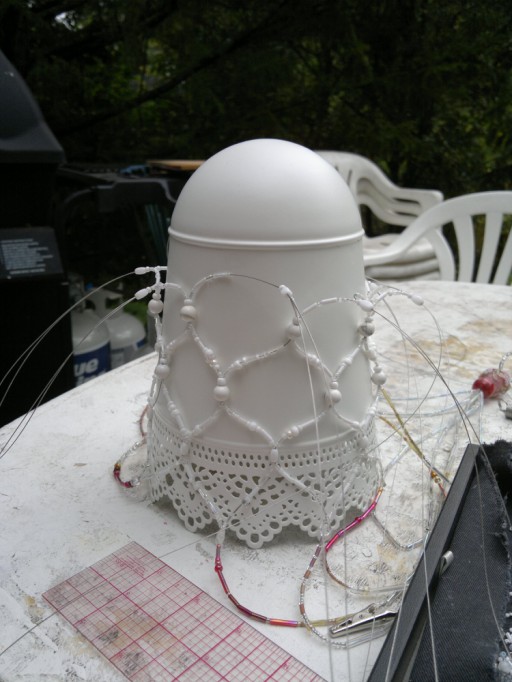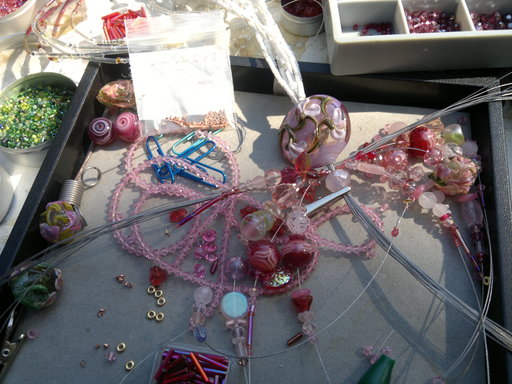Part III of a picture tutorial on how I make my beaded plant hangers: a bit more about finishing the meshes, and the reasoning and construction for the tassel, which is the raison d'etre of making these things:)
As I explained in the last page, I usually make these things with two meshes[1] and three ‘courses’; this one has 4 meshes and 5 courses, because I had double the number of strands (16 instead of 8) to make this practical. Threading a mature plant through even 4 hanging strands can be pest, let alone 8 or more—probably makes more sense to purchase a small one, and let it grow;)
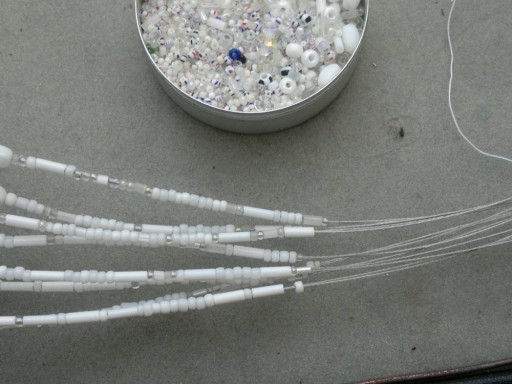
last row of netting: note strands are doubled thru the beads, to provide the base or cup of the netting to hold pot in place. These doubled 8 strands will converge in a large holed bead at the bottom center of the pot. Because the pot bottom is curved, the finishing strands are much longer than is typical.
One of my long term explorations has been making ‘reverse teardrop’ style tassels—sort of like Dale Chihuly's big hanging sculptures (which by the way you can think of as assemblages of giant off-center-hole beads, though each component is individually attached to what I suspect [originally, anyway] was a single pole, as opposed to being threaded on multiple strands the way I do it.)
This means I want the long strands to hang together, in a clump, not spread, as they do in the green plant hanger. The way to achieve this, I reasoned, is to make a core of long strands, strung only with small beads (say 3 or 4mm max) and cover them with an outer ring or cap of shorter strands strung with the dramatic lampwork beads.
But where to get the extra strands?
That is the problem the ‘cross-strung’ extra pieces of tigertail, shown below, are meant to solve.
Above, you can see the ‘cross’ pieces of tigertail held in place by the vertical tigertail squeezed between the upper and lower beads. These shorter horizontal pieces will fill out the top of the tassel, relying upon tightly strung beads to hold them in place.
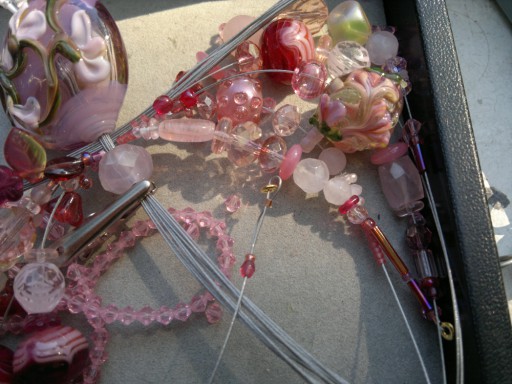
Closeup of tassel construction. This shows even more clearly the construction detail of the ‘reverse’ or upside down teardrop style of tassel, with beads on some of the horizontal ‘filler’ strands.
If you've ever looked at a picture of some of the larger atoms, one of the fascinating things about them is that the various electron orbitals—predictions of where a given electron is most likely to be—assume ever more complex shapes as the numbers of electrons in a given shell grow. Thus, s electron fields are roughly spherical; p's are dumb-bells; and by the time you get to d and f, you're getting weird rings and teardrops. But the reason the shapes get more complex is that more and more electrons have to squash themselves in.
It kind of blew my mind that chemistry—which is basically the study of the way these differing electrons fit together to make molecules—is all about shape. Electrons are held in place by their attraction to the nucleus; the beads by the crimp on the tigertail, which similarly prevents them from flying away. I just love the way they lock into place, like electrons:)[2]
Below, most of the outer (i.e. horizontal strands) are done
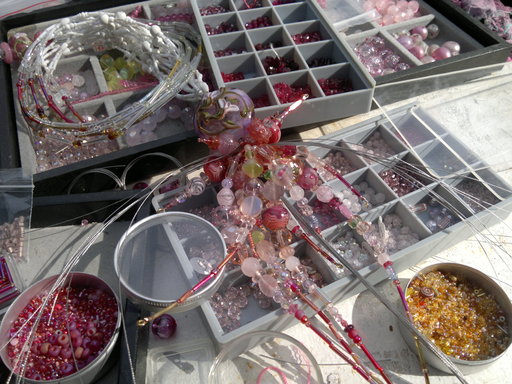
Tassel construction in progress: Much of ‘cap’ part is done. Some pieces are very short and stick straight out; others are a bit longer and droop. The longest strands to form the core remain to be strung.
part I part II part IV–completed
[1]Or three, if you include the hanging strand as the top half of the first mesh, or diamond.
[2]Really. Writing this post makes me realize that Dale Chihuly sculptures have probably inspired my desire to make large massed-bead objects that hang in the sun in general and tassels in particular, but even my delight in the chihuly is founded on that property of electron orbitals. I'll always be grateful to my chemistry profs at Albion, because their textbook had these cool topographic illustrations of the orbitals that I really, really liked. Those images are perhaps the most valuable thing I took away from my inorganic chemistry class.
Unless otherwise noted, text, image and objects depicted therein copyright 1996--present sylvus tarn.
Sylvus Tarn